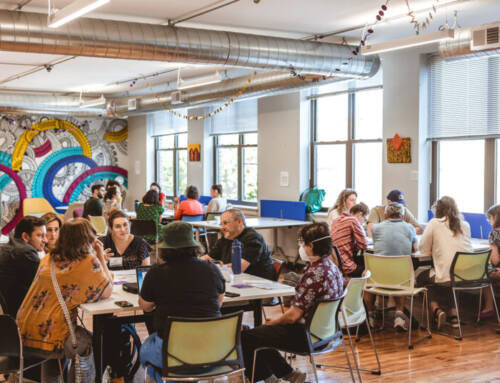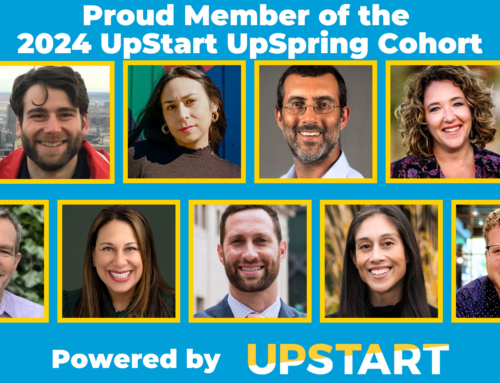Like the secular world, the organized Jewish community today has a bit of a crush on entrepreneurs. In a recent New York Times Magazine article, Nathaniel Richm quotes Paul Buchheit, a partner at Y Combinator, a Silicon Valley based incubator searching for the next founders of a billion-dollar company: “If there’s going to be another Sergey Brin and Larry Page, and anyone can be Sergey and Larry, then it’s only logical for investors to bet on as many founders as possible. You can’t win the game unless you ante up.” Y Combinator, and other Silicon Valley investors, are in the game to win; they want to find the people behind the next “big idea” and they want a piece of their big, hypothetical pie.
The Jewish community is also focused on this “next big idea,” which, though may not make us billionaires, might single-handedly manage to keep Judaism alive and relevant for current and future generations. In the frantic search for this next “big idea” and the individuals behind it, we have invested significant communal resources into cultivating, celebrating, and mentoring individuals with promise and potential. This approach suggests that the ultimate success of Jewish communal life depends upon talented, creative, and charismatic individuals who can create the large-scale changes our community needs.
While this approach has generated a variety of successes and critical contributions to the Jewish community, it it should not be the only approach for the work our community is trying to do (and it is also still unclear as to whether or not it is the most effective approach to replicating successes like Google and Facebook). At the very least, it should be one strategy among many in our attempt to bring the changes and creativity needed for the Jewish community to thrive. Long term, systemic innovation is quite complex, and depends upon a variety of approaches to accomplish its goals.
Our work over the course of the past few months with teachers and administrators from a diverse array of New York City Jewish Day Schools participating in the inaugural year of the Day School Collaboration Network – DSCN (an initiative of The Jewish Education Project and UpStart Bay Area, made possible by a generous grant from UJA Federation of New York), has confirmed that at least one approach we should be taking very seriously in the Jewish community is an attitude of “Radical Collaboration.” This term, from the methodology of ‘Design Thinking‘, embraces the theory that creativity and innovation emerge when you put people together who do not normally collaborate, and empower and trust them to identify and tackle systemic, far-reaching issues in their environments. We have seen that creating opportunities for collaboration, within and across a diverse array of day schools, can drive Jewish day school educators to actively identify and address shared educational and systematic challenges. The teachers who have participated in our pilot year were accustomed to working in relative isolation, on very specific issues related to their classrooms. We have provided them with the opportunity, and the trust, to collaborate with people with whom they normally would not interact, despite the fact that they work in the same school. With these new interconnections amongst educators and between teachers and administrators, more of their creativity has surfaced, and with it the depth of potential impact in their school systems, and in the Jewish Day School system at large. After only a few months of work together, these teachers are making substantive systemic and programmatic changes in their schools, for example: re-thinking Tefillah programs, in order to make prayer experiences more relevant and accessible to students; re-thinking the design of after-school student groups; coming up with creative approaches for more differentiated learning in the classroom; and even re-designing a school’s drop-off and pick-up experience. The collaboration in our network has been built through in-person meetings, shared coaching, and through social media.
This type of collaboration has led to enhanced creativity and innovation, and has created a shared sense of responsibility for creating the types of schools, and by extension, Jewish community, that we envision. All too often, teachers and administrators in our schools work in isolation. Creating a culture of radical collaboration within and amongst these schools will take time. Working and learning with the outstanding professionals in the DSCN, we have begun to identify the specific ingredients necessary for radical collaboration:
- A Networked Approach: By definition, networks are horizontal structures. Our work this year has confirmed that when teachers perceive of themselves as active partners in the success of their schools, despite their titles or roles, they are more likely to bring their full selves to the table and make an impact. Networks also thrust people from various backgrounds and roles together. When individuals are empowered to work in a non-hierarchical environment, with the full support of their Heads of School, collaboration is more likely to occur, and more likely to yield measurable results.
- A Shared Methodology: We have learned that collaboration is more successful when there is a shared container for the collaboration. In our network, Design Thinking has served as a shared language and set of tools, which create cohesion and connectivity amongst team members and between the various schools. This methodology reinforces the value of collaboration and experimentation, which creates a positive feedback loop that encourages teams to work together.
- Empowered Individuals: Too often, particularly in the current climate of austerity, Jewish day school educators are under-resourced, which limits creativity in the classroom and the school. The DSCN offers seed funding to schools in order to test creative models of curriculum, programming and systems. The teams in each school know that they are empowered not only to think theoretically about the challenges and opportunities they identify, but also to test their ideas, make mistakes, learn from them, and thereby make a real impact in their environments. As a result of the financial and human resources we are providing these teams, they have become more collaborative and more creative.
- Public Acknowledgement of Initiative: Day school educators receive isolated appreciation from students, parents and colleagues. Much of their work is unrecognized beyond their individual school settings. After experimenting with and producing new models that are affecting changes in the schools, the DSCN will promote the educators and their work across the field and the larger Jewish and general communities. It is harder to collaborate when feeling isolated from the whole. By publicly celebrating these teams, by connecting them to other schools, and to researchers, funders, and community members, the network participants understand that they are working within a broad system towards a shared goal – the betterment of that system and of the composite success of the community – and this enhances their desire to collaborate and contribute to the system as a whole.
The Rabbis of the Talmud, in founding the halachic system which has guided Jewish life from Biblical to modern times, understood that a community seeking to stay relevant needs to empower both the creative, and sometimes radical, voices of individuals, and the community as a whole. Starting with the Mishna, the Rabbis provide an honored place for the voice of the Daát Yachid – the individual, often dissenting voice in the academy. However, they also established that the values and practices of a community must emerge through the collective process of theBeit Din – the setting in which issues were debated and eventually articulated into standing practice and policy. We need our charismatic, bold yichidim, our visible entrepreneurs, and their new initiatives. And we also need to trust and empower each and every one of the individuals engaged in our community, and find the underlying seeds of innovation and creativity that will flourish when they come together.
Originally published in eJewish Philanthropy
Our purpose is to enable entrepreneurs to bring bold Jewish ideas to light. We help them reach Up to people in new ways that are meaningful, more inclusive, and create a brighter future for our Jewish community and the world we share.




